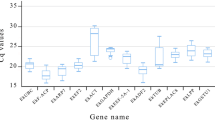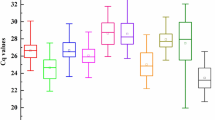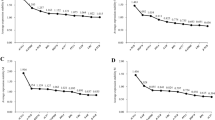Abstract
Paeonia ostii seeds have recently been identified as a new source of α-linolenic acid in China. Studying the gene expression patterns of unsaturated fatty acid-related genes would be helpful for understanding the mechanism of α-linolenic acid accumulation. Quantitative real-time polymerase chain reaction (qRT-PCR) is a useful method for reliably evaluating gene expression, and it is necessary to select reliable reference genes for data normalization in qRT-PCR analysis. In this study, we evaluated the expression stability of 12 candidate reference genes using four mathematical algorithms (∆Ct, BestKeeper, NormFinder, and geNorm). The web-based tool RefFinder was used to integrate the results and to provide a comprehensive ranking order. The expression stability ranking orders of reference genes were different caculated by these four algorithms, and the ranking order analyzed by the RefFinder was UBQ > Tip41 > UCE > EF-1α > α-TUB > PP2A > ACT > GAPDH > SAM > CYP > β-TUB > 18S at the different seed development stages, and UBQ > Tip41 > EF-1α > α-TUB > PP2A > UCE > GAPDH > SAM > ACT > CYP > 18S > β-TUB in P. ostii tissues. UBQ and Tip41 are the two most stable whereas 18S and β-TUB are the two least stable reference genes for gene expression in various tissues and seeds at different developmental stages in P. ostii.



Similar content being viewed by others
References
Chen FY, Li JJ (1998) Exportation of Chinese tree peonies (Mudan) and their development in other countries I: cultivated. J Northwest Norm Univ 34:109–116
Li SS, Wang LS, Shu QY, Wu J, Chen LG, Shao S, Yin DD (2015) Fatty acid composition of developing tree peony (Paeonia section Moutan DC.) seeds and transcriptome analysis during seed development. BMC Genomics 16:208
Li XQ, Han JG, Liu Z, Liu QH, Hu YH (2014) Economic characteristics investigation and seed oil fatty acid composition analysis of Paeonia ostii plants in different areas. Cereals Oils 27:43–46
Qi JC, Zhou HM, Ma JQ, Li P (2005) Analysis of the chemical constituents in peony seed oil by GC-MS. J Cereals Oils 11:22–23
Bustin SA, Benes V, Nolan T, Pfaffl MW (2005) Quantitative real-time RT-PCR—a perspective. J Mol Endocrinol 34:597–601
Gachon C, Mingam A, Charrier B (2004) Real-time PCR: what relevance to plant studies? J Expl Bot 55:1445–1454
Kanakachari M, Solanke AU, Prabhakaran N, Ahmad I, Dhandapani G, Jayabalan N, Kumar PA (2016) Evaluation of suitable reference genes for normalization of qPCR gene expression studies in Brinjal (Solanum melongena L.) during fruit developmental stages. Appl Biochem Biotechnol 178:433–450
Nicot N, Hausman JF, Hoffmann L, Evers D (2005) Housekeeping gene selection for real-time RT-PCR normalization in potato during biotic and abiotic stress. J Exp Bot 56:2907–2914
Ute A, Kimd B (2008) Gene expression in Citrus sinensis (L.) Osbeck following infection with the bacterial pathogen Candidatus Liberibacter asiaticus causing Huanglongbing in Florida. Plant Sci 175:291–306
Wang X, Liu A (2014) Expression of genes controlling unsaturated fatty acids biosynthesis and oil deposition in developing seeds of Sacha inchi (Plukenetia volubilis L.). Lipids 49:1019–1031
Hu Y, Chen H, Luo C, Dong L, Zhang SW, He XH, Huang GX (2014) Selection of reference genes for real-time quantitative PCR studies of kumquat in various tissues and under abiotic stress. Sci Hortic 174:207–216
Niu LJ, Tao YB, Chen MS, Fu QT, Li CQ, Dong YL, Wang XL, He HY, Xu ZF (2015) Selection of reliable reference genes for gene expression studies of a promising oilseed crop, Plukenetia volubilis, by real-time quantitative PCR. Int J Mol Sci 16:12513–12530
Wang ML, Li QH, Xin HH, Chen X, Zhu XJ, Li XH (2017) Reliable reference genes for normalization of gene expression data in tea plants (Camellia sinensis) exposed to metal stresses. PLoS ONE 12:e0175863
Zhu XY, Li XP, Chen WX, Chen JY, Lu WJ, Lei C, Fu DW (2012) Evaluation of new reference genes in papaya for accurate transcript normalization under different experimental conditions. PLoS ONE 7:e44405
Silver N, Best S, Jiang J, Thein SL (2006) Selection of housekeeping genes for gene expression studies in human reticulocytes using real-time PCR. BMC Mol Biol 7:33
Pfaffl MW, Tichopad A, Prgomet C, Neuvians TP (2004) Determination of stable housekeeping genes, differentially regulated target genes and sample integrity: BestKeeper—Excel-based tool using pair-wise correlations. Biotechnol Lett 26:509–515
Vandesompele J, De Preter K, Pattyn F, Poppe B, Van Roy N, Paepe AD, Speleman F (2002) Accurate normalization of real-time quantitative RT-PCR data by geometric averaging of multiple internal control genes. Genome Biol. https://doi.org/10.1186/gb-2002-3-7-research0034
Andersen CL, Jensen JL, Orntoft TF (2004) Normalization of real-time quantitative reverse transcription-PCR data: a model-based variance estimation approach to identify genes suited for normalization, applied to bladder and colon cancer data sets. Cancer Res 64:5245–5250
Xie F, Xiao P, Chen D, Xu L, Zhang B (2012) miRDeepFinder: a miRNA analysis tool for deep sequencing of plant small RNAs. Plant Mol Biol 80:75–84
Hofmann J, Grundler FMW (2007) Identification of reference genes for qRT-PCR studies of gene expression in giant cells and syncytia induced in Arabidopsis thaliana by Meloidogyne incognita and Heterodera schachtii. Nematology 9:317–323
Jain M, Nijhawan A, Tyagi AK, Khurana JP (2006) Validation of housekeeping genes as internal control for studying gene expression in rice by quantitative real-time PCR. Biochem Bioph Res Commun 345:646–651
Pabuayon IM, Yamamoto N, Trinidad JL, Longkumer T, Raorane ML, Kohli A (2016) Reference genes for accurate gene expression analyses across different tissues, developmental stages and genotypes in rice for drought tolerance. Rice 9:32
Li J, Han JG, Hu YH, Yang J (2016) Selection of reference genes for quantitative real-time PCR during flower development in tree peony (Paeonia suffruticosa Andr.). Front Plant Sci 7:516
Okuley J, Lightner J, Feldmann K, Yadav N, Lark E, Browse J (1994) Arabidopsis FAD2 gene encodes the enzyme that is essential for polyunsaturated lipid synthesis. Plant Cell 6:147–158
Livak KJ, Schmittgen TD (2001) Analysis of relative gene expression data using real-time quantitative PCR and the 2−ΔΔCT method. Methods 25:402–408
Narancio R, John U, Mason J, Spangenberg G (2018) Selection of optimal reference genes for quantitative RT-PCR transcript abundance analysis in white clover (Trifolium repens L.). Funct Plant Biol 45:737–744
Cao J, Wang L, Lan H (2016) Validation of reference genes for quantitative RT-PCR normalization in Suaeda aralocaspica, an annual halophyte with heteromorphism and C4 pathway without Kranz anatomy. PeerJ 4:e1697
Chang E, Shi SQ, Liu JF, Cheng TL, Xue L, Yang XY, Yang WJ, Lan Q, Jiang ZP (2012) Selection of reference genes for quantitative gene expression studies in Platycladus orientalis (Cupressaceae) using real-time PCR. PLoS ONE 7:e33278
Yi SJ, Qian YQ, Han L, Sun ZY, Fan CM, Liu JX, Ju GS (2012) Selection of reliable reference genes for gene expression studies in Rhododendron micranthum Turcz. Sci Hortic 138:128–133
Li XY, Cheng JY, Zhang J, da Silva JAT, Wang CX, Sun HM (2015) Validation of reference genes for accurate normalization of gene expression in Lilium davidii var. unicolor for real time quantitative PCR. PLoS ONE 10:e0141323
Chen X, Mao YJ, Huang SW, Ni J, Lu WL, Hou JY, Wang YT, Zhao WW, Li MH, Wang QJ (2017) Selection of suitable reference genes for quantitative real-time PCR in Sapium sebiferum. Front Plant Sci 8:637
Zhuang H, Fu Y, He W, Wang L, Wei Y (2015) Selection of appropriate reference genes for quantitative real-time PCR in Oxytropis ochrocephala Bunge using transcriptome datasets under abiotic stress treatments. Front Plant Sci 6:475
Long X, He B, Gao X, Qin Y, Yang J, Fang Y, Qi J, Tang C (2015) Validation of reference genes for quantitative real-time PCR during latex regeneration in rubber tree. Gene 563:190–195
Galli V, Borowski JM, Perin EC, Messias RD, Labonde J, Pereira ID, Silva SD, Rombaldi CV (2015) Validation of reference genes for accurate normalization of gene expression for real time-quantitative PCR in strawberry fruits using different cultivars and osmotic stresses. Gene 554:205–214
Acknowledgements
This work was supported by the National Natural Science Foundation of China (31500534), the Startup Fund for Advanced Talents of Zhoukou Normal University (ZKNU2014108), the School-Based Program of Zhoukou Normal University (ZKUNB115203), the Natural Science Foundation of Henan province (162300410346), and the Key Scientific Research Project in Colleges and Universities of Henan Province (15A180024).
Author information
Authors and Affiliations
Contributions
CL and LH designed research; CL, LH, XW, HL, HT and JW performed experiments. CL and LH wrote the paper.
Corresponding author
Ethics declarations
Conflict of interest
All authors declare that they have no conflicts of interest.
Additional information
Publisher's Note
Springer Nature remains neutral with regard to jurisdictional claims in published maps and institutional affiliations.
Electronic supplementary material
Below is the link to the electronic supplementary material.
Electronic supplementary material 1 (TIFF 1728 kb)
Fig. S1 Pairwise variation analysis by geNorm to determine the optimal number of reference genes needed for accurate normalization in seeds at different developmental stages and across various tissues in Paeonia ostii. Cutoff value = 0.15
Rights and permissions
About this article
Cite this article
Li, C., Hu, L., Wang, X. et al. Selection of reliable reference genes for gene expression analysis in seeds at different developmental stages and across various tissues in Paeonia ostii. Mol Biol Rep 46, 6003–6011 (2019). https://doi.org/10.1007/s11033-019-05036-7
Received:
Accepted:
Published:
Issue Date:
DOI: https://doi.org/10.1007/s11033-019-05036-7




